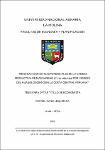Mostrar el registro sencillo del ítem
Pérdidas económicas potenciales en la cadena productiva de mandarinas (Citrus reticulata) por ingreso del Huanglongbing en la Costa Central peruana
| dc.contributor.advisor | Mercado Curi, Waldemar Fernando | |
| dc.contributor.author | Cano Lequerica, Rafael | |
| dc.date.accessioned | 2023-11-08T15:39:26Z | |
| dc.date.available | 2023-11-08T15:39:26Z | |
| dc.date.issued | 2023 | |
| dc.identifier.uri | https://hdl.handle.net/20.500.12996/6050 | |
| dc.description | Universidad Nacional Agraria La Molina. Facultad de Economía y Planificación. Departamento Académico de Economía y Planificación | es_PE |
| dc.description.abstract | Perú se ha consolidado como exportador de mandarina principalmente al Asia y Europa gracias a su calidad. Esta bonanza está amenazada por el ingreso de la enfermedad del Huanglongbing (HLB), reportada en países de la región donde ha dejado consecuencias nefastas para la producción de cítricos. El objetivo de la tesis fue determinar las pérdidas económicas potenciales que generaría el ingreso del HLB en la cadena productiva de mandarina en la Costa Central del Perú (provincias productoras de Lima e Ica), en diversos escenarios prospectivos para el periodo 2024 - 2040, estimando la relación Beneficio / Costo de potenciales pérdidas económicas evitadas en caso de ponerse en ejecución un Programa Nacional Fitosanitario (PNF). En el análisis prospectivo, se usó un Modelo Lineal simple para la proyección tendencial de la producción, y un modelo epidemiológico para los escenarios con HLB y el impacto de la implementación del PNF. Se realizó un análisis Beneficio / Costo para calcular los costos asociados a la entrada del HLB y el impacto de la implementación del PNF en cultivos de mandarina. Las simulaciones de escenarios confirman el impacto negativo del ingreso del HLB en el año 2024 en la cadena productiva directa de mandarina en la Costa Central, así como los diversos niveles de pérdidas económicas ocasionadas según el nivel de implementación del PNF en los productores de mandarina de esta zona. Se concluye que se confirma que el ingreso del HLB en Costa Central produciría en el año 2040 la caída de la producción de mandarina en un 78 % si no se aplicase el PNF que limite los efectos nocivos y que permita continuar las actividades productivas y comerciales. | es_PE |
| dc.description.abstract | Peru has established itself as a tangerine exporter mainly to Asia and Europe thanks to its quality. This bonanza is threatened by the entry of the Huanglongbing disease (HLB), reported in countries of the region where it has had disastrous consequences for citrus production. The objective of the thesis was to determine the potential economic losses that the entry of HLB would generate in the mandarin production chain in the Central Coast of Peru (producing provinces of Lima and Ica), in various prospective scenarios for the period 2024 - 2040, estimating the Benefit / Cost ratio of potential economic losses avoided in the event of implementing a National Phytosanitary Program (PNF). In the prospective analysis, a simple Linear Model was used for the trend projection of production, and an epidemiological model for the scenarios with HLB and the impact of the implementation of the PNF. A Benefit / Cost analysis was carried out to calculate the costs associated with the entry of the HLB and the impact of the implementation of the PNF on mandarin crops. The scenario simulations confirm the negative impact of the entry of the HLB in the year 2024 in the direct productive chain of mandarins in the Central Coast, as well as the different levels of economic losses caused according to the level of implementation of the PNF in the mandarin producers of this zone. It is concluded that it is confirmed that the entry of the HLB in the Central Coast would produce a 78% drop in mandarin production in 2040 if the PNF was not applied to limit the harmful effects and to allow productive and commercial activities to continue. | es_PE |
| dc.format | application/pdf | es_PE |
| dc.language.iso | spa | es_PE |
| dc.publisher | Universidad Nacional Agraria La Molina | es_PE |
| dc.rights | info:eu-repo/semantics/openAccess | es_PE |
| dc.rights.uri | https://creativecommons.org/licenses/by-nc-nd/4.0/ | es_PE |
| dc.subject | Calidad | es_PE |
| dc.subject | Mandarinas | |
| dc.subject | Evaluación | |
| dc.subject | Citrus reticulata | |
| dc.subject | Perdidas | |
| dc.subject | Perú | |
| dc.title | Pérdidas económicas potenciales en la cadena productiva de mandarinas (Citrus reticulata) por ingreso del Huanglongbing en la Costa Central peruana | es_PE |
| dc.type | info:eu-repo/semantics/bachelorThesis | es_PE |
| dc.coverage | ||
| thesis.degree.discipline | Economía | es_PE |
| thesis.degree.grantor | Universidad Nacional Agraria La Molina. Facultad de Economía y Planificación | es_PE |
| thesis.degree.name | Economista | es_PE |
| dc.subject.ocde | https://purl.org/pe-repo/ocde/ford#4.05.00 | es_PE |
| renati.author.dni | 71618297 | es_PE |
| dc.publisher.country | PE | es_PE |
| dc.type.version | info:eu-repo/semantics/publishedVersion | es_PE |
| renati.advisor.orcid | https://orcid.org/0000-0001-7167-9581 | es_PE |
| renati.advisor.dni | 06445350 | es_PE |
| renati.type | https://purl.org/pe-repo/renati/type#tesis | es_PE |
| renati.level | https://purl.org/pe-repo/renati/level#tituloProfesional | es_PE |
| renati.discipline | 311016 | es_PE |
| renati.juror | Jiménez Díaz, Luis Alberto | |
| renati.juror | Diez Matallana, Ramón Alberto | |
| renati.juror | Rojas Cubas, Juan Carlos |
Ficheros en el ítem
Este ítem aparece en la(s) siguiente(s) colección(ones)
-
EPL-EP Tesis [166]




